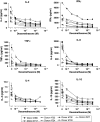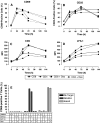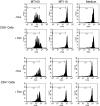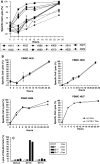The effect of dexamethasone on polyclonal T cell activation and redirected target cell lysis as induced by a CD19/CD3-bispecific single-chain antibody construct
- PMID: 17310380
- PMCID: PMC11030660
- DOI: 10.1007/s00262-007-0298-z
The effect of dexamethasone on polyclonal T cell activation and redirected target cell lysis as induced by a CD19/CD3-bispecific single-chain antibody construct
Abstract
BiTE molecules comprise a new class of bispecific single-chain antibodies redirecting previously unstimulated CD8+ and CD4+ T cells for the elimination of target cells. One example is MT103 (MEDI-538; bscCD19xCD3), a CD19-specific BiTE that can induce lysis of normal and malignant B cells at low picomolar concentrations, which is accompanied by T cell activation. Here, we explored in cell culture the impact of the glucocorticoid derivative dexamethasone on various activation parameters of human T cells in response to MT103. In case cytokine-related side effects should occur with BiTE molecules and other T cell-based approaches during cancer therapy it is important to understand whether glucocorticoids do interfere with the cytotoxic potential of T cells. We found that MT103 induced in the presence of target cells secretion by peripheral T cells of interleukin (IL)-2, tumor necrosis factor-alpha (TNF-alpha), interferon-gamma (IFN-gamma), IL-6, IL-10 and IL-4 into the cell culture medium. Production of all studied cytokines was effectively reduced by dexamethasone at a concentration between 1 and 3x10(-7) M. In contrast, upregulation of activation markers CD69, CD25, CD2 and LFA-1 on both CD4+ and CD8+ T cells, and T cell proliferation were barely affected by the steroid hormone analogue. Most importantly, dexamethasone did not detectably inhibit the cytotoxic activity of MT103-activated T cells against a human B lymphoma line as investigated with lymphocytes from 12 human donors. Glucocorticoids thus qualify as a potential co-medication for therapeutic BiTE molecules and other cytotoxic T cell therapies for treatment of cancer.
Figures





References
-
- Bargou R, Kufer P, Kirchinger P, Noppeney R, Schuler M, Viardot A, Weigang-Koehler K, Zettl F, Gerecke C, Libicher M, Einsele H, Riethmuller G, Lutterbuese R, Klinger M, Baeuerle PA, Schlereth B, Reinhardt C (2006) MT103 (anti-CD19 × anti-CD3-BiTE) induces B cell depletion, clearance of bone marrow infiltration and clinical responses in heavily pre-treated NHL patients: first data from dose-escalation study MT103-104. In: 11th congress of European hematology association. Ref type: Abstract
-
- Brischwein K, Schlereth B, Guller B, Steiger C, Wolf A, Lutterbuese R, Offner S, Locher M, Urbig T, Raum T, Kleindienst P, Wimberger P, Kimmig R, Fichtner I, Kufer P, Hofmeister R, da Silva AJ, Baeuerle PA. MT110: a novel bispecific single-chain antibody construct with high efficacy in eradicating established tumors. Mol Immunol. 2006;43:1129–1143. doi: 10.1016/j.molimm.2005.07.034. - DOI - PubMed
MeSH terms
Substances
LinkOut - more resources
Full Text Sources
Other Literature Sources
Medical
Research Materials

